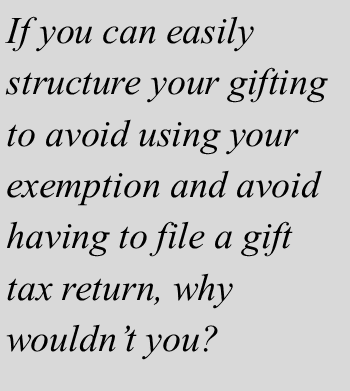HOW TO PRESERVE YOUR EXEMPTION AND AVOID FILING A GIFT TAX RETURN USING SIMPLE GIFTING PRINCIPLES
A client of mine recently asked for advice on a set of gifts he was planning to make. He was considering making large cash gifts to his siblings and wanted to know the tax consequences. I suggested that he and his wife avoid consuming their gift tax exemptions by spreading the gifts over a few years, if possible. He wasn’t interested in this approach. I then advised him to elect gift splitting with his wife to, at a minimum, shelter a portion of each gift from gift tax. Based on this exchange, it seemed timely to devote this blog post to explaining simple ways that taxable gifts and IRS filing requirements can be avoided.
In 2019, every U.S. citizen and resident has a federal estate and gift tax exemption of $11.4 million. This means that those individuals can transfer $11.4 million during life or at death without owing gift or estate tax. Any person can also make “present interest” gifts totaling $15,000 per recipient, per year (or $30,000 per recipient, per year for spouses who elect to gift split). Once the total amount of gifts to a recipient in a tax year exceeds the $15,000/$30,000 annual exclusion, the excess is considered a taxable gift (unless another exemption or deduction applies) and the donor will be required to file a gift tax return to report the gift to the IRS. If the donor has gift tax exemption available, the donor won’t have to pay tax on the gift, but will have to consume part of the donor’s gift tax exemption. While there are reasons beyond the scope of this blog that a donor may wish to make gifts that consume his or her lifetime exemption, it’s important to understand how simple, nontaxable gifts can be made in the event you wish to make a gift larger than the annual exclusion or you’re trying to incrementally reduce your taxable estate.
One simple way to make nontaxable gifts is to make sure your gifts each year don’t exceed the annual exclusion per recipient. If you wish to make a gift to an individual greater than the annual exclusion, consider making the gift in annual installments. For example, to make a $60,000 gift to a relative, you could stretch the gift over 4 years by gifting $15,000 per year (or 2 years at $30,000 per year if you’re gift splitting with your spouse). If you’re trying to reduce your taxable estate, annual exclusion gifts can be an effective way to transfer significant amounts of wealth each year. For example, if you have 3 children and 7 grandchildren, you could transfer $15,000 to each for a total transfer of $150,000 (or $300,000 if you’re gift splitting with your spouse) each year. Note that the gifts to your grandchildren would need to be made outright or to trusts with specific provisions so that the gifts qualify as “present interest” gifts. Another option is to make your gift to a 529 college saving plan, which can be frontloaded with a lump-sum contribution prorated over 5 years, allowing an initial gift of $75,000 (or $150,000 if you’re gift splitting with your spouse).
As noted, spouses can make an election to gift split so that each gift during a tax year is treated as made one-half by each spouse. The amount passing to the recipient is the same whether or not gift splitting is elected, but with gift splitting, one spouse may make the entire gift from his or her separate account with a $30,000 exclusion, instead of a $15,000 exclusion. A gift splitting election is made on a gift tax return (Form 709) and applies to all gifts made during that tax year. Although a gift tax return for simple annual exclusion gift splitting is relatively simple, the return can be avoided if each spouse makes a separate gift (assuming each spouse has assets to make separate gifts). For example, instead of one spouse writing a check for $30,000 and filing a gift tax return to elect gift splitting with his or her spouse, each spouse could write a check for $15,000 from their separate accounts to the same recipient and avoid having to file a gift tax return. The end result is the same, but no gift tax return would be required.

If you can easily structure your gifting to avoid using your exemption and avoid having to file a gift tax return, why wouldn’t you? Keeping your gifts under the annual exclusion and making exempt gifts for tuition and medical expenses are great ways to optimize your gifting in a simple, tax-efficient way.
DISCLAIMER: The issues discussed in this article are for your general information only and are not intended as legal or tax advice. For specific information on particular factual situations and before implementing any of the gifting strategies discussed in this article, you should obtain the advice of an attorney.
IRS CIRCULAR 230 DISCLOSURE: Under U.S. Treasury regulations, we are required to inform you that any tax advice contained in this article is not intended to be used, and cannot be used, to avoid penalties imposed under the Internal Revenue Code.
Hayley Strong Hall is an attorney with Davis Matthews & Quigley, P.C. of Atlanta, Georgia. Her practice focuses on Estate Planning and Wealth Management, Mergers and Acquisitions, Taxation, and Fiduciary Litigation.

